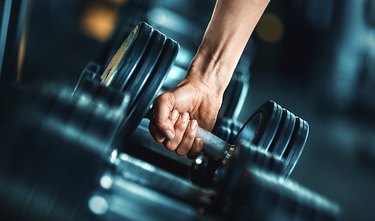
If you're looking for a way to train your chest and back at the same time, then there are two words for you: dumbbell pullover. The dumbbell or db pullover is a staple in many split routines and bodybuilding workouts because it's one exercise that hits many muscles. Some training plans include it as part of a push/pull day, while others add it to a single body part day such as chest day.
Tip
The dumbbell pullover exercise is a chest exercise that works muscles in the upper body, including the pectoralis major, pectoralis minor, latissimus dorsi, triceps and abdominal muscles.
Video of the Day
DB Pullover Targets Chest Muscles
If there is one muscle group that gets tasked with the most work in the db pullover, it's your chest muscles. The chest muscles include the pectoralis major, which is the larger of the two chest muscles, and directly underneath it, the pectoralis minor.
Video of the Day
There are two parts to the pectoralis major: the clavicular head and sternal head. During a dumbbell pullover, the sternal head, which is bigger than the clavicular head, does the majority of the work. Which makes sense, especially when you consider that the sternal head originates on the sternum, extends across your upper torso and attaches to the upper arm bone — which are all areas of your chest that are working when performing the db pullover.
Since the pectoralis major and pectoralis minor are prime movers in the db pullover exercise, it makes sense that many training programs include this exercise as part of a chest day. If you're breaking up your workouts into body part splits, performing the db pullover on an upper-body day or chest-specific day will work. And if your resistance training typically consists of full body workouts, consider adding the dumbbell pullover to one of the full body days.
Read more: The Best Workout for Cutting Up Your Chest
DB Pullover Stretches Back Muscles
The beginning phase of the dumbbell pullover requires you to extend your arms over your head. As you work through this movement pattern, you will feel your back stretch, and more specifically, your latissimus dorsi, which is the muscle that originates on the lower half of your back and attaches to the inside of your upper arm.
The latissimus dorsi plays a role in the dumbbell pullover because it works collaboratively with the teres major and pectoralis major to perform actions of the upper extremity. Another primary function of the latissimus dorsi is to extend, adduct and medially rotate the humerus, which is your arm bone. This action is what allows you to initiate the db pullover and extend your arms over your head.
Unless you're an anatomy wizard, there are some muscles you may not know the proper name for, and that's OK, just as long as you feel them when performing the dumbbell pullover. In addition to the pectoralis major, pectoralis minor and back muscles, when you perform the db pullover correctly, you'll also feel the muscles in your upper abs, triceps, rhomboids, intercostal muscles and serratus anterior working to help execute this move.
Read more: Ultimate Back and Shoulder Workouts
Common Mistakes With DB Pullover
Like any other intermediate resistance training exercises, there are some common mistakes people make when performing the dumbbell pullover.
- Going too fast. Moving too fast through the db pullover exercise puts added strain on the back muscles, especially when they are stretching in the downward phase of the exercise. Slow down and focus on proper form and technique.
- Using too heavy of a resistance. This is not the exercise to test the limits of your strength, especially when starting out. It's a good idea to stick to a lower weight until you master the technique of the dumbbell pullover. Once you know how to perform this move, you can increase the amount of weight you use. But continue to aim for lower resistance and a higher repetition range.
- Performing the dumbbell pullover with a shoulder injury. If you have a current shoulder injury, you should avoid the db pullover. Older injuries or chronic pain may also flare up when performing this exercise. Start out with very light resistance and only do the db pullover if you don't experience pain in your shoulder.